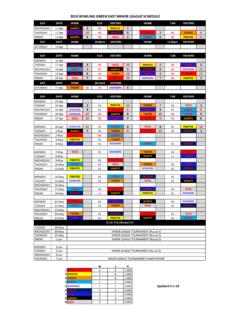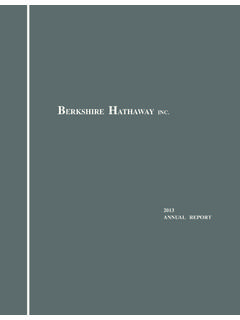Transcription of Contents
1 Flash to read and share!Consult this publication on line at work is published on the OECD iLibrary, which gathers all OECD books, periodicals and statistical for more Science, Technology and Industry Scoreboard 2013 INNOVATION FOR GROWTHS cience, technology, innovation and entrepreneurship which foster competitiveness, productivity, and job creation are important mechanisms for encouraging sustainable growth. Over 250 indicators in the OECD Science, Technology and Industry (STI) Scoreboard show how OECD and major non-OECD economies are performing in a wide range of areas to help governments design more effective and effi cient policies and monitor progress towards their desired charts and underlying data in the STI Scoreboard 2013 are available for download and for the fi rst time, selected indicators contain additional data expanding the time and country coverage of the print Knowledge economies.
2 Trends and features Building knowledge Connecting to knowledge Targeting new growth areas Unleashing innovation in fi rms Competing in the knowledge economy Participating in the global economyFor more information about the OECD STI Scoreboard, see Science, Technology and Industry Scoreboard 2013 INNOVATION FOR GROWTHOECD Science, Technology and Industry Scoreboard 2013 INNOVATION FOR GROWTHISBN 978-92-64-20073-992 2013 05 1 P9 HSTCQE*caahdj+OECD Science,Technology and IndustryScoreboard 2013 This work is published on the responsibility of the Secretary-General of the OECD. Theopinions expressed and arguments employed herein do not necessarily reflect the officialviews of the Organisation or of the governments of its member document and any map included herein are without prejudice to the status of orsovereignty over any territory, to the delimitation of international frontiers and boundariesand to the name of any territory, city or 978-92-64-20073-9 (print)ISBN 978-92-64-20500-0 (PDF)ISBN 978-92-64-203181 (HTML)Biennial:ISSN 1562-983X (print)ISSN 2072-5345 (online)1.
3 Note by Turkey:The information in this document with reference to Cyprus relates to the southern part of the Island. There is nosingle authority representing both Turkish and Greek Cypriot people on the Island. Turkey recognises the TurkishRepublic of Northern Cyprus (TRNC). Until a lasting and equitable solution is found within the context of the UnitedNations, Turkey shall preserve its position concerning the Cyprus issue .2. Note by all the European Union Member States of the OECD and the European Union:The Republic of Cyprus is recognised by all members of the United Nations with the exception of Turkey. Theinformation in this document relates to the area under the effective control of the Government of the Republic statistical data for Israel are supplied by and under the responsibility of the relevant Israeli authorities or thirdparty.
4 The use of such data by the OECD is without prejudice to the status of the Golan Heights, East Jerusalem andIsraeli settlements in the West Bank under the terms of international credits:Cover Sergey ; to OECD publications may be found on line OECD 2013 You can copy, download or print OECD content for your own use, and you can include excerpts from OECD publications, databases andmultimedia products in your own documents, presentations, blogs, websites and teaching materials, provided that suitableacknowledgment of the source and copyright owner is given. All requests for public or commercial use and translation rights should besubmitted Requests for permission to photocopy portions of this material for public or commercial use shall beaddressed directly to the Copyright Clearance Center (CCC) the Centre fran ais d'exploitation du droit de copie(CFC) cite this publication as.
5 OECD (2013),OECD Science, Technology and Industry Scoreboard 2013,OECD SCIENCE, TECHNOLOGY AND INDUSTRY SCOREBOARD 2013 OECD 20133 ForewordThe OECDS cience, Technology and Industry Scoreboard 2013draws on the latestinternationally comparable data to uncover the strengths of OECD and other leading economies andexplore the continuing challenges to overcome the effects of the recent financial and economic features indicators traditionally used to monitor developments in science, technology, innovationand industry, and complements them with new and experimental indicators that provide newinsights into areas of policy STI Scoreboard is not about ranking countries or developing composite indicators. It isabout giving policy makers and analysts the means of comparing economies with others of a similarsize or with a similar structure and monitor progress towards desired national or supranationalpolicy goals.
6 It draws on the OECD s efforts to build the data infrastructure needed to link actors,outcomes and impacts; it highlights the potential and the limits of certain metrics and points todirections for further are pointers. They do not address causal relations. Moreover, the validity of a set ofindicators depends on its use. The selected indicators have been developed with the following criteriain mind: Indicators should be based on high-quality statistics and robust analytical principles and bemeasurable internationally, over time and with prospects of improvement. Indicators should be relevant, particularly for decision makers. Experimental indicators that complement more established ones bring new perspectives andadvance the measurement agenda.
7 They help to stimulate continuing and new policy debates anduncover new first chapter,Knowledge economies: trends and features, provides a broad looks at innovation, firm dynamics, productivity and jobs against the backdrop of the ,thechanging landscape of innovation, the features of science today and the characteristics of innovationbeyond formal research and thematic chapters focus on areas of key policy interest: Building knowledgelooks at the knowledge assets that many firms and governments view astheir current and future sources of long-term sustainable growth. It focuses on indicators ofknowledge-based capital and on the jobs and employment related to it, scientific skills andeducation, and investment in research. It also presents experimental indicators of public fundingand new estimates of R&D tax incentives.
8 Connecting to knowledgehelps inform the policy debate with a set of metrics on the varietyand nature of mechanisms for knowledge exchange. Among the indicators presented are theimpact of scientific collaboration (based on patent citations) and science-industry linkages (basedon citations of non-patent literature in patent documents). Also included are new indicators onFOREWORDOECD SCIENCE, TECHNOLOGY AND INDUSTRY SCOREBOARD 2013 OECD 20134researcher mobility that track the careers of scientists who publish in scholarly journals and on theextent of firms collaboration in innovation processes. Targeting new growth areasexamines the direction of countries scientific efforts and thetechnologies on which they build their comparative advantage. It presents R&D and innovationindicators in biotechnology and nanotechnology and in health, environmental and information andcommunication technologies, and looks at developments in smart ICT infrastructure.
9 It alsoreveals how the development of technologies accelerates over time and how innovations emergefrom the combination of different technologies. Unleashing innovation in firmsis concerned with the dynamism of the business sector andshows the strong contribution of young firms to job creation using new microdata-basedindicators. It looks at the main ways in which firms innovate and proposes a novel indicator on theintellectual property bundle to point to firms joint use of patents, trademarks and industrialdesigns to protect their innovations. New data on registered designs provide information on howcountries protect creativity. Other indicators address the extent to which governments create theconditions for young innovative firms to grow and the broader policy environment for innovation.
10 Competing in the knowledge economylooks at how countries seek to build their competitivestrengths and uses a wide range of more sophisticated indicators than those that are generallyavailable. It considers industrial specialisation and diversification, R&D and trade specialisation,technological advantages and relative strengths, as well as the characteristics of innovative firmsand their use of new technologies in business processes. Participating in the global economydraws out the implications of structural characteristicsfor economies participation in global value chains. Indicators related to firms size, survival andgrowth and to foreign affiliates accompany employment patterns in key industries and linkagesbetween manufacturing and services.
















